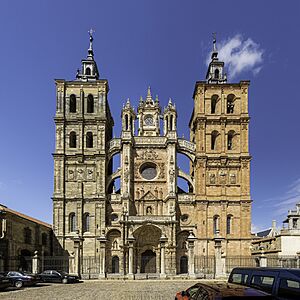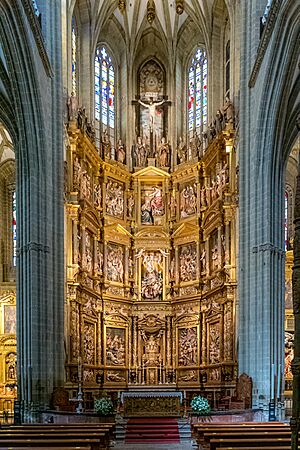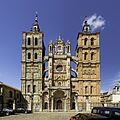Astorga Cathedral facts for kids
Quick facts for kids Astorga Cathedral |
|
|---|---|
| Cathedral of Saint Mary | |
| Catedral de Santa María | |

West façade in 2021.
|
|
| 42°27′28″N 6°03′25″W / 42.45778°N 6.05694°W | |
| Location | Astorga |
| Country | Spain |
| Denomination | Catholic |
| History | |
| Status | Cathedral |
| Dedication | Mary, mother of Jesus |
| Dedicated | 1069 |
| Architecture | |
| Architect(s) | Juan de Colonia, Rodrigo Gil de Hontañón |
| Style | Late Gothic (interior), Baroque (west façade) |
| Groundbreaking | 1471 |
| Administration | |
| Metropolis | Oviedo |
| Diocese | Astorga |
The Cathedral of Saint Mary (in Spanish, Catedral de Santa María) is a beautiful Catholic church located in Astorga, Spain. It is a very important building and was officially named a national monument in 1931.
Contents
A Look at the Cathedral's History
The building you see today started being built in 1471. It stands on the same spot where older churches, built between the 11th and 13th centuries, once stood. These older churches were built in a style called Romanesque.
Building the current cathedral took a very long time, all the way until the 18th century! Because of this, it has a mix of different architectural styles.
Different Building Styles
The main part of the cathedral was built in the Gothic style. This style often features tall, pointed arches and large windows.
Later, new parts were added in other styles. For example, the cloister, which is a covered walkway, was built in the 18th century in a Neo-Classicist style. The impressive towers and the front of the cathedral (called the west façade) were built in the Baroque style. You can also see some Renaissance elements in the entrance area.
The cathedral has a rectangular shape and is very bright inside. Its design is quite similar to some Gothic churches found in Germany.
Amazing Artworks Inside
The Astorga Cathedral is home to many incredible artworks.
- One important piece is the retablo of St. Michael. A retablo is a large, decorated structure behind the altar in a church. This one shows a mix of Flemish and Spanish art styles.
- The main altar, called the high altar, was created by Gaspar Becerra in 1558. It is considered a masterpiece of Spanish Renaissance sculpture.
- You can also see sculptures like the "Purísima" by Gregorio Fernández (made in 1626).
- There are also statues of "St. John the Baptist and St. Jerome" by Mateo del Prado from the 17th century.
- Another special sculpture is the "Christ of the Waters," which dates back to the 14th century.
The Episcopal Palace
Right next to the cathedral is the Episcopal Palace. This building has a Neo-medieval style. It was designed by the famous architect Antoni Gaudí, who is known for his unique and imaginative buildings, especially in Barcelona.
Images for kids
See also
 In Spanish: Catedral de Astorga para niños
In Spanish: Catedral de Astorga para niños






